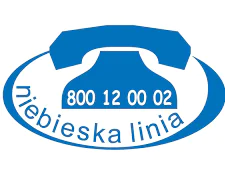
Domestic violence is a difficult and serious social issue. At the same time, it is a personal tragedy that unfolds in the everyday lives of many people – including refugees. As psychologists emphasize, the most important thing is to start talking about your own difficulties and to reach out for help. Many organizations in Poland offer support to those affected by violence. State assistance is also available. To ensure proper protection for those harmed or at risk of violence, the so-called Blue Card has been introduced. This is a special tool intended to monitor the situation and systematically assist the affected individual and their close ones.
Domestic Violence – Definition and Forms
Domestic violence is one of the most complex and multifaceted problems. It refers to deliberate actions or omissions that violate the rights or personal well-being of those in one’s immediate environment. Such actions can affect the physical, emotional, and psychological well-being of the victims, or significantly impede their daily functioning.
The definition of domestic violence is broad. It includes deliberate actions or omissions that violate the rights or personal well-being of family members or other individuals who live or manage a household together. We can distinguish among its forms the following:
- Psychological violence – includes various forms of manipulation, humiliation, shouting, intimidation, or isolation. Trying to convince someone that “it’s their fault,” “they deserved it,” or that they are worthless also constitutes violence. Although it leaves no visible marks on the body, its impact on the victim’s psyche can be very serious;
- Sexual violence – situations in which the victim is forced into sexual contact against their will. This includes not only rape but also any violation of intimacy;
- Economic violence – involves controlling the victim’s access to financial resources, depriving them of the opportunity to earn money, or manipulating their finances;
- Other forms of violence – these include actions like destroying property, deliberately neglecting someone in need of care (e.g., the elderly or a person with disabilities), or directing threats at the victim.
The victims of domestic violence can be spouses, partners in informal relationships, children, family members, the elderly, and people with disabilities.
What is the Blue Card?
The Blue Card is a set of actions undertaken by representatives of social assistance units, police, education, and healthcare services in situations where there are suspicions of domestic violence. It has been in operation in Poland since 2011. The aim of the Blue Card is to provide protection for those affected by violence and to take action against those who perpetrate violence.
Anyone who suspects that there is domestic violence in a given family should report this fact to the police. This can also be done anonymously. The victim or their relatives can also go to a police station, social assistance center, medical facility, or a commission combating alcoholism. In such cases, the services are obliged to issue a Blue Card.
Remember! The Blue Card is issued immediately upon receipt of the report. Only after the procedure has been initiated do the services verify the situation. If the victim is in danger, the police can immediately order them to leave the residence.

Jak zakłada się Niebieską Kartę?
The Blue Card is not issued by the victim themselves, but by the appropriate officials. Most often, this is a police officer. The procedure is as follows:
- First, a police officer, social worker, or doctor initiates the procedure. To do this, they fill out a special NK-A form. They document the reported situation and the actions taken on site.
- The officials then provide the victim with a Card B. This document contains the definition of violence, human rights, and information on where to get help. Form B is not given to the person suspected of committing domestic violence.
- The next step is to forward the NK-A form to an interdisciplinary team that analyzes the family situation and completes the NK-C form. The working group consists of people from various professions needed in the given situation. Its members may include, among others: a police officer, a social assistance specialist, a school psychologist, a representative from an organization helping victims, a member of the Commission for Alcohol-Related Problems, a court probation officer, or a guardian from a community center. This group reviews the available materials and contacts the victim of violence to discuss possible assistance. Card C is then monitored and adjusted to the situation and needs of the victim.
- The person who is perpetrating violence is also invited for individual conversations with the working group. During this meeting, the group fills out the NK-D card. The purpose of the meeting is to present the legal and psychological consequences of using violence and to indicate ways to change behavior.
Download: On the Blue Line website, you can find the B forms of the Blue Card in Ukrainian and Russian languages.
The person experiencing violence is consistently informed about the progress of the procedure. They have a say in what happens in their case and what actions will be taken.
What Information Does the Blue Card Contain?
The termination of the Blue Card procedure only occurs if the domestic violence has ceased or if there is no justification for further action. If the person is still experiencing violence, they should notify the police or prosecutor again. They will also be referred to entities and organizations involved in combating domestic violence.
The NK-A form filled out by the official contains the following information:
- place and date of the discovery of violence,
- witness information (if they consent to it),
- personal information of the victim of violence,
- personal information of the person suspected of committing violence,
- information about the type and scale of violence used,
- information on children who have witnessed the violence,
- information on previous interventions and suspicions,
- description of the incident,
- recommendations for further action.
After completing the card, an interdisciplinary team consisting of various specialists (social workers, psychologists, lawyers) decides on further steps, such as isolating the victim from the aggressor or taking legal action against the perpetrator.
Jeśli ofiarami przemocy pada więcej niż jedna osoba, np. rodzic i dzieci, lub kilkoro dzieci, Niebieską Kartę wypełnia się osobno dla każdego pokrzywdzonego.
The Blue Card is not the only option. Where can one seek help?
The Blue Card procedure is a systemic solution, but it’s not the only one and it’s not mandatory. A person who has experienced violence can also seek support independently.
Various organizations provide advice and assistance. Often, it is during consultations in the safe environment of foundations, associations, or centers that the decision is made to report the matter to the appropriate authorities. “We provide assistance to all female migrants who come to us with the issue of domestic violence. However, we do not issue Blue Cards. The decision to initiate such a procedure always belongs to the woman,” says an expert from the Women’s Support Center operating in Warsaw: Centrum Wsparcia Kobiet.
You can find contacts for organizations operating at the local level in various regions, as well as national helplines, in the article “List of Support Organizations for Victims of Violence in Poland” on Mapuj Pomoc.
Consultations concerning the NK (Blue Card) procedure can also be carried out by calling the Nationwide Emergency Service for Victims of Domestic Violence “Niebieska Linia” (Blue Line): Ogólnopolskie Pogotowie dla Ofiar Przemocy w Rodzinie „Niebieska Linia”. The “Niebieska Linia” Association offers round-the-clock assistance not only to those experiencing violence, but also to witnesses and anyone seeking information on ways to combat domestic violence. How can you contact the Blue Line? There are several ways and forms of help available:

- Phone: 800 120 002 (available 24/7); English-language shift – Mondays from 6 PM to 10 PM; Russian-language shift – Tuesdays from 6 PM to 10 PM; Legal shift – Wednesdays from 6 PM to 10 PM,
- Phone: 22 666 28 50 – legal shifts (Mondays and Tuesdays from 5 PM to 9 PM),
- e-mail: [email protected]
- SKYPE: Sign language shift – pogotowie.niebieska.linia (Mondays from 1 PM to 3 PM).
In special cases, the “Niebieska Linia” Association takes intervention measures that involve contacting local services with a request for specific actions and intervention.
You can also contact the Victims’ Helpline at +48 222 309 900. The hotline is available 24/7, including in English, Russian, and Ukrainian.
Jeśli doświadczasz przemocy, pamiętaj: nie jesteś sam! Nie jesteś sama! Otwarcie na szczerą rozmowę z bliską osobą bądź specjalistą na infolinii czasem okazuje się najważniejszym krokiem ku wyjściu z kryzysowej sytuacji. Jeśli to zawodzi lub nie masz możliwości uzyskania pomocy od przyjaciół i bliskich, szukaj wsparcia w lokalnych instytucjach i organizacjach lub zadzwoń na ogólnopolskie infolinie. Nawet jeśli nie uda ci się od razu otrzymać bezpośredniej pomocy, specjalista naprowadzi cię na odpowiednie kroki.
Sources
Niebieska karta: Co to jest, jak ją założyć. Jak wygląda procedura, „Dziennik Gazeta Prawna” [access: August 1, 2023].
Stowarzyszenie Interwencji Prawnej, Jak najlepiej zgłosić przemoc domową wobec ukraińskiej mamy dwójki dzieci przez Polską kobietę która zabrała ich pod swój dach? [access: August 1, 2023].
Niebieska Linia, Rozporządzenie w sprawie procedury „Niebieskiej Karty” – komentarz [access: August 9, 2023].
Przemoc? Nie czekaj! Co warto wiedzieć o procedurze Niebieskiej Karty, substantive editing: Renata Durda, Pogotowie „Niebieska Linia” Instytut Psychologii Zdrowia PTP, Warszawa 2005.
